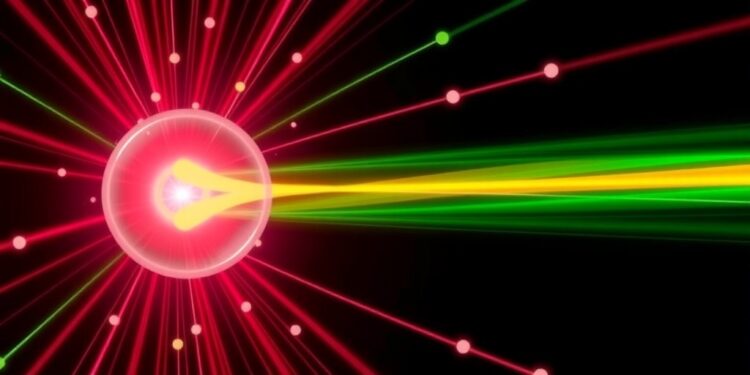
Researchers at Lund University in Sweden have achieved a groundbreaking milestone in the field of quantum physics. For the first time, they have successfully measured the quantum state of electrons that are ejected from atoms after absorbing high-energy light pulses. This significant advancement opens new avenues for understanding the intricate interactions between light and matter. The study’s results contribute to a deeper comprehension of quantum behavior and its implications in various scientific domains.
When atoms or molecules interact with high-energy light, particularly in the extreme ultraviolet or X-ray range, a phenomenon known as the photoelectric effect occurs. This process results in the detachment of an electron, called a photoelectron, from the atom. The kinetic energy of these emitted electrons provides a wealth of information about the original atom being irradiated. This fundamental principle underlies the practice of photoelectron spectroscopy, a technique extensively used in the study of atomic and molecular structures. However, traditionally, the emitted electrons were treated as classical particles, neglecting their inherent quantum properties.
In reality, photoelectrons represent quantum objects that cannot be fully understood through classical physics. Their behavior necessitates a quantum mechanical approach, as these electrons exhibit properties akin to both particles and waves. The latest technique devised by the Lund University researchers, known as KRAKEN, allows them to address a critical question: to what extent can we characterize the quantum state of the emitted photoelectron? Drawing an analogy to medical imaging techniques like CT scans, the researchers employ a series of laser pulses to capture two-dimensional representations of the quantum state, which are then reconstructed into a comprehensive three-dimensional profile.
Through the application of this innovative measurement method, the researchers successfully measured the quantum states of photoelectrons emitted from helium and argon atoms. Importantly, their findings reveal that the quantum state of the emitted electrons is influenced by the type of material from which they originate. This discovery has far-reaching implications, especially given that the photoelectric effect was first elucidated by Albert Einstein more than a century ago, forming the bedrock for modern quantum mechanics.
The significance of the study extends beyond fundamental physics; it opens possibilities for practical applications in various fields. The researchers assert that while the current study focused on simple atomic systems such as helium and argon, future applications could include investigating complex systems found in molecular gases, liquids, and solids. An understanding of how ionized targets react to the sudden loss of an electron at a quantum level could prove crucial in areas such as atmospheric photochemistry and energy-harvesting technologies, including solar cells and the natural photosynthesis observed in plants.
Another key aspect of this groundbreaking work is its ability to connect diverse scientific disciplines. It bridges the realms of attosecond science and spectroscopy, areas where significant advancements have been made by researchers like Nobel Prize laureate Anne L’Huillier. At the same time, it intersects with emerging fields in quantum information and technology. This multi-disciplinary approach highlights the relevance of this study in the context of the ongoing second quantum revolution, which aims to manipulate individual quantum entities to harness their properties for practical applications.
Furthermore, the implications for societal advancements are profound. While the current measurement technique may not lead directly to the construction of new quantum computers, it offers unprecedented access to the quantum states of photoelectrons. This enhanced understanding could empower physicists and engineers to fully exploit these quantum properties, paving the way for innovations and applications that were previously unattainable.
In addition to its potential applications, the study sheds light on fundamental questions about the nature of quantum mechanics. For instance, why don’t we observe quantum effects in macroscopic objects? Researchers explain that at the microscopic scale, electrons, atoms, and molecules follow the laws of quantum mechanics, while larger objects adhere to classical physics. The phenomenon of decoherence plays a pivotal role here, as groups of quantum entities interact uncontrollably, effectively masking their individual quantum traits. The new technique not only aims to measure these traits but also seeks to track how quantum properties evolve over time, transitioning from quantum to classical behavior.
The researchers expressed their astonishment not only at the successful implementation of the new measurement method but also at how effectively it worked. Previous attempts to analyze the quantum state of photoelectrons had proven extremely challenging, requiring exceptionally stable conditions over extended periods. Achieving such stability represents a remarkable feat, highlighting the innovative nature of the KRAKEN technique.
This pioneering research is poised to transform the landscape of photoelectron spectroscopy, allowing scientists to glean deeper insights into the quantum world. By measuring the speed and emission direction of photoelectrons, researchers can unlock valuable information about material structures, enabling the exploration of novel materials and their properties. As a result, this work holds the promise of not only advancing our fundamental understanding but also catalyzing practical advancements across various scientific disciplines.
In summary, the groundbreaking measurement of photoelectron quantum states by researchers at Lund University marks a significant achievement, one that has potential ramifications in understanding quantum behavior and its applications in technology and materials science. The integration of quantum mechanics and spectroscopy in this innovative framework paves the way for future research that may unravel the complexities of light-matter interactions, opening doors to revolutionary technologies and scientific discoveries.
Subject of Research: Quantum state measurement of photoelectrons
Article Title: Measuring the quantum state of photoelectrons
News Publication Date: October 2023
Web References: Lund University
References: Busto, D. et al. (2023). Measuring the quantum state of photoelectrons. Nature Photonics.
Image Credits: Lund University
Keywords
Quantum mechanics, photoelectric effect, photoelectron spectroscopy, quantum state tomography, light-matter interactions, KRAKEN technique, helium, argon, decoherence, quantum properties, attosecond science, spectroscopy.
Tags: extreme ultraviolet light effectshigh-energy light interactionsimplications of quantum state measurementslight-matter interactions in physicsLund University research breakthroughphotoelectric effect in quantum physicsphotoelectron quantum propertiesphotoelectron spectroscopy advancementsquantum behavior in electronsquantum mechanics of photoelectronsquantum state measurementunderstanding quantum objects





